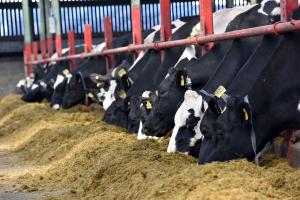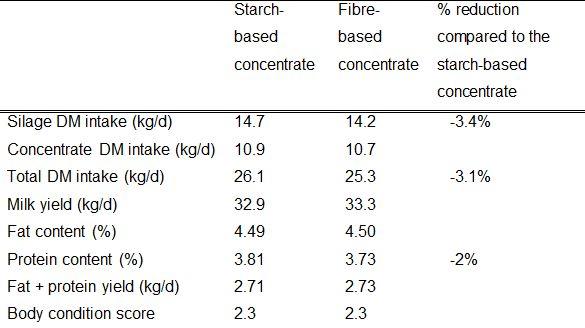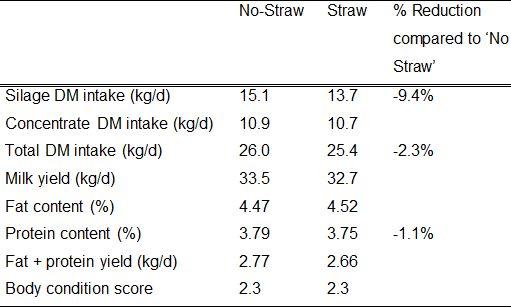AFBI research examines supplementation strategies for high quality grass silage
Date published:
When silage quality is improved, milk yields increase, or alternatively, concentrate levels can be reduced. Therefore, improving silage quality should be a target for all dairy farmers in Northern Ireland. However, there are concerns that when cows are offered silages with a very high digestibility, rumen health and digestive efficiency will be adversely affected due to insufficient fibre in the diet.

Background
This situation may be made worse if high quality silages are supplemented with high levels of starch-based concentrates, which normally increase performance, but also potentially increase the risk of acidosis. As a consequence, supplementing very high quality silages with fibre-based concentrates rather than starch-based concentrates is often advised.
In addition, the inclusion of small quantities of chopped straw in high quality diets is often advocated if diets are believed to contain insufficient ‘functional fibre’. In theory, straw inclusion will increase saliva production and rumination, and stabilise rumen pH but could also reduce intakes.
The objectives of the current study were to examine the effect of concentrate type (starch-based or fibre-based), and straw inclusion (straw or no straw) on dairy cow performance, when offered alongside a very high quality grass silage.

This short-term study involved twenty-four mid-lactation dairy cows. All cows were offered a high quality grass silage, which had a dry matter content of 42%, a crude protein content of 17%, and a metabolisable energy content of 12.1 MJ per kg of dry matter (DM). Four treatments, comprising different supplementation strategies, were examined, as follows:
- Starch-based concentrate, no straw
- Starch-based concentrate, plus chopped straw
- Fibre-based concentrate, no straw
- Fibre-based concentrate, plus chopped straw
All diets were prepared using a mixer wagon and offered as a total mixed ration. The mix provided approximately 12 kg concentrate per cow per day. Cows on the straw treatment were offered approximately 1.0 kg straw per day. The starch-based concentrate contained a high proportion of maize meal and had a starch content of 33% and a fibre content of 21% (fresh basis). In contrast, the fibre-based concentrate contained 21% starch and 31% fibre (fresh basis), and contained a high proportion of soya hulls and beet pulp. Both concentrates had a crude protein content of 14.5% (fresh basis).
Outcomes
The response to straw inclusion in the diet was the same with both types of concentrate (i.e. there was no interaction), and this allows us to examine the effect of concentrate type (Table 1) and straw inclusion (Table 2) separately.
Effect of concentrate type
Silage dry matter intakes (DMI) of cows offered the fibre-based concentrate were 3.4% lower than those of cows offered the starch-based concentrate, and this resulted in a reduction in total DM intake. While milk yield was unaffected by concentrate type, milk protein content was reduced by 2% when the fibre-based concentrate was offered, perhaps due to the lower intake with this treatment.
While starch-based concentrates are often associated with a reduction in milk fat content, no such effect was observed in the current study. This is likely due to the concentrates being formulated using ‘NutriOpt’, a rationing programme that takes into account the ‘structural fibre index’ and ‘acid load’ of the ration. Therefore, although the fibre and starch content of the diets where different, the starch-based diet had enough effective dietary fibre to promote rumination and stimulate intakes.
Table 1: Effect of concentrate type on cow performance

Effect of straw inclusion
Silage DM intake was reduced by 9.4% when straw was included in the diet, the straw replacing some of the silage. In addition, straw inclusion in the diet reduces the speed at which food moves through the digestive tract, and this contributed to the reduction in total DM intake. However, despite the lower intakes, milk yield was not reduced by straw inclusion, although milk protein content was reduced by 1.1%. This reduction in milk protein content is likely due to the straw diluting the energy density of the diet. These findings agree with earlier research undertaken at AFBI, which found straw inclusion to have no beneficial effect on cow performance or digestibility.
Table 2: Effect of straw inclusion on cow performance

Implications
The results of this experiment have a number of practical implications. Firstly, starch-based concentrates can improve intakes and milk protein content, compared to fibre-based concentrates. In addition, a very high quality grass silage can be supplemented with a starch-based concentrate with no adverse effects on performance, provided rations are formulated to support rumen health using modern dairy cow rationing programs.
While there may have been an expectation that supplementing a starch-based concentrate with straw would improve digestibility and intakes, this study did not support these expectations.
Furthermore, this study failed to demonstrate any practical benefits of including straw in properly balanced dairy cow diets, with intakes and milk protein content actually reduced with straw inclusion.
Notes to editors:
AFBI carries out high quality technology research and development, statutory, analytical, and diagnostic testing functions for DAERA and other Government departments, public bodies and commercial companies.AFBI's Vision is “Advancing the Local and Global Agri-Food Sectors Through Scientific Excellence”.AFBI's core areas:- Leading improvements in the agri food industry;- Protecting animal, plant and human health;- Enhancing the natural and marine environment. All media enquiries to AFBI Press Office 028 9025 5326.